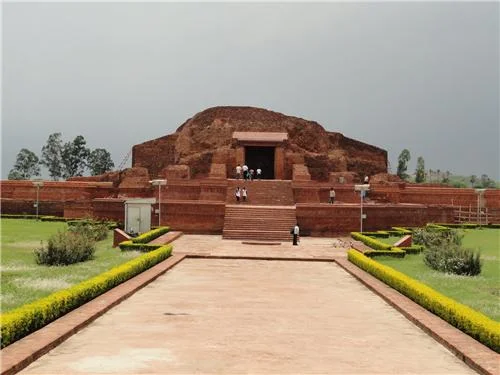
Bhagalpur district is located in the central part of Bhagalpur division. Bhagalpur city is the headquarters of the Bhagalpur Division and also of the District and Sadar Subdivision. There are 3 subdivisions namely, Naugachia, Bhagalpur Sadar and Kahalgaon in the district. Number of C.D. Blocks in the district are 16. There are 1515 villages and 4 statutory towns in the district. Bhagalpur district, as it is currently composed, encompassed the southeastern part of the Subah of Bihar in Mughal times. When the Diwani of Bihar, Bengal and Orissa was assigned to the East India Company in 1765, the district was a large area to the east of Sarkar Munger and, with the exception of Pargana Chhai, was entirely south of the Ganges. This also included Munger which was separated in 1832 and Santhal Pargana was formed into a separate district in 1855-56. The area of the Ganges district was thus greatly reduced. In the year 1954, the entire area north of the Ganges, with the exception of the police stations of Bihpur, Naugachhia and Gopalpur, was transformed into the new Saharsa district. In the year 1991, Banka subdivision of the district was given the status of a district.Bhagalpur, as currently composed, contains three subdivisions namely Bhagalpur Sadar, Naugachhia and Kahalgaon consisting of 16 Community Development Block-cum-Anchals. authentic report is available on origin of name Bhagalpur. In the Bengal District Gazetteer, Bhagalpur, 1911, it has been rightly noted that the boundaries of Bhagalpur district are purely artificial, and no connection with the area now bearing this name can be expected. However, according to the Bhagalpur District Gazetteer (1962), Buchanan noted in his diary that the name is said to have been given by the Mughal officers who gathered a number of fugitives and defended them in the plains against the violence and looting. of the disorderly leaders of the interior.
Following traditions preserved in the epics and puranas, the descendants of Anu, Manus great-grandson, founded the Anava kingdom in the east. After that, this kingdom was divided among the five sons of King Bali, known as Anga, Vanga, Kalinga, Pundia and Sumha. Among the kings of Anga of whom there is some reference was Lomapada, a contemporary and friend of King Dashrath of Ayodhya. His great-grandson was Champa after whom the capital of Anga, known until then as Malini, was renamed Champa. Anga, along with Magadh, is first mentioned in Vedic literature in the Atharvaveda Samhita. In Buddhist scriptures, Anga is mentioned as one of the several kingdoms of North India. According to a tradition, Brahmadatta, the king of Anga, defeated Bhattiya, the king of Magadh. But his son, Bimbisar (c. 545 BCE), avenged his fathers defeat and subdued Anga. Ajatshatru, the next king of Magadh, is said to have transferred his capital to Champa. Subhadrangi, Ashokas mother, was a poor Brahmin girl from Champa who was given in marriage to Bindusar. Anga remained part of the Magadhan Empire under the Nandas, the Mauryas (324-185 BCE), The Sugas (185-75 BCE)) and the Kanvas (75-30 BCE). During the rule of the Kanvas, King Kharavela of Kalinga invaded Magadh and Anga. The history from the next few centuries to the coronation of Chandragupta I (in AD 320) is rather murky. Anga was part of the great Gupta Empire (320-455 AD). This was an era of great material and cultural progress. With the decline of the Guptas, the Gaud king Sasanka took control of the area in 602 AD. And retained his rule until his death in 625 AD. His death marked the decline of Gauds power and the area later came under Harshas sphere of influence. He installed Madhav Gupta as king of Magadh. His son Adityasena left an inscription in Mandar Hill indicating that he installed Narsimha or Narhari Temple, Hiuen Tsang visited Champa during his travels. He left a description of the city in his travelogues. The Palas of Bengal came to power in 755 AD with the election of Gopala as king. He conquered Bihar. Dharmapala succeeded him. Vigrahpala established his authority in Anga. A copper plate attributed to his son Narayanpal has been found in Bhagalpur. Vikramshila, the seat of the famous university, was founded by Gopala. The Senas also ruled Anga after the fall of the Palas.

